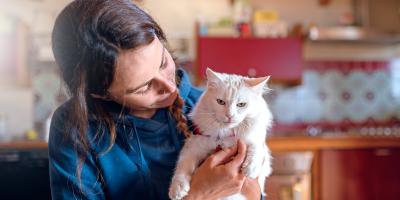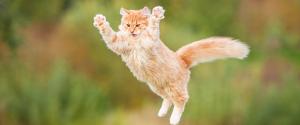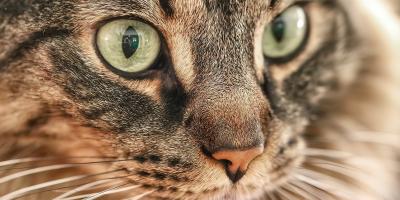
If you've watched your cat attempting to navigate a high ledge or leaping off an unstable surface during a play session, you've probably noticed their almost supernatural ability to always land feet first. But is the distinctly feline trick of flipping into a perfect landing real, or have you just caught your kitty performing once-in-a-lifetime acrobatic manoeuvres?
Do Cats Always Land on Their Feet?
Cats are, in fact, fantastic at making acrobatic flips that turn them in the proper direction for a safe landing, but their ability isn't foolproof.
Sometimes cats can't flip quickly enough or misjudge their manoeuvre. Fortunately for your feline, mishaps are rare. Most of the time, your kitty companion can adjust their position mid-fall to land safely with all four feet on the ground.
Why Do Cats Land on Their Feet?
The reason cats land on their feet has to do with an innate reflex called the righting reflex. Specific aspects of a cat's anatomy make it easier for felines to flip over to a right-side-up position.
Inside your cat's ear is a special structure called the vestibular apparatus, which helps them balance and orient themselves. The vestibular apparatus lets your cat quickly recognize which direction is up and which is down. Once a cat recognizes where they are in relation to the ground, they can turn their head and body to face the right way for a perfect landing.
Another contributor to a cat's ability to land feet first when falling has to do with their unique skeletal structure. Your cat has a flexible backbone with 30 individual vertebrae, and a cat skeleton has no collarbone. This flexibility lets cats quickly make corrections to body orientation during a fall.
Cats also have a low body size to weight ratio, which helps reduce their speed when falling and makes it easier to turn various parts of their body on the way down. When the cat lands, their angled muscular legs help reduce the force of the impact.
How Do Cats Flip to Land on Their Feet?
When a cat starts to fall, they immediately begin to right themselves by arching their back and orienting their head in the right direction. The spine twists to follow the direction of the head, and the forepaws move up toward the face to protect the delicate head area.
How Was the Feline Righting Reflex Discovered?
Humans have been living with cats for a long time, so people probably noticed their feline friends' ability to flip midair during a fall long before scientists thought about studying the reflex. By the early 19th century, scientists were actively trying to figure out how cats managed this manoeuvre.
For a while, it was believed that cats would somehow push off from the hand of a person who dropped them, but in 1894, a French scientist named Etienne-Jules Marey used a chronophotographic camera to capture a cat's fall on film. Marey watched the 60-frame-per-second film in slow motion to observe the mechanisms behind the flip in detail.
Can Kittens Land on Their Feet?
The righting reflex develops fairly early in a young cat's life. Kittens as early as 3 weeks old have been observed righting themselves during a short fall, and by 7 weeks of age, most kittens have a fully developed righting reflex. Kittens develop this reflex all on their own.
Why Do Cats Always Land on Their Feet?
Cats evolved the ability to land on their feet because they are natural climbers. The urge to get high up where they can keep an eye on things is part of normal cat behaviour. Climbing trees and jumping up onto high structures can be dangerous activities, so cats have adapted to reduce possible damage if they fall.
Does Height Affect Whether a Cat Lands on Their Feet?
The height a cat falls from could affect their ability to flip over in time for a safe landing. A 1987 study by the New York City Animal Medical Centre found that cats who fell from multi-storey buildings survived 90% of the time, and only 37% of the cats who fell multiple storeys required emergency veterinary care. Cats who fell from heights between 7 and 32 storeys fared better than those who fell from just 2- to 6-storey heights.
One reason that height may affect the fall is because the longer the fall, the more time a cat has to flip over to the best orientation for a safe landing. A cat's maximum velocity is also slower than a human's, and once they reach maximum velocity, a cat can spread out their legs to expand their body and create air resistance to slow them down further.
Why Do Some Cats Not Land on Their Feet?
Some cats aren't as good at doing the full-body flip as others. Overweight cats may have trouble fully executing the righting reflex manoeuvre. Senior cats may also develop health issues that make it harder to flip during a fall.
Even if your cat is an expert at landing feet first, it's still important to protect your feline friend from falls. Keeping windows closed or installing window guards can help keep your pet safe, particularly if you live in a tall building.
If your cat does experience a high fall, take them to the vet for a checkup even if they seemed to survive the incident without injury. Your cat could successfully flip right the side up but still incur internal injuries that you can't see.
Related articles



